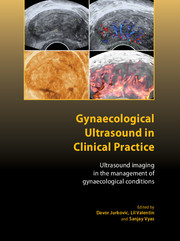 Gynaecological Ultrasound in Clinical Practice
Gynaecological Ultrasound in Clinical Practice Published online by Cambridge University Press: 05 February 2014
Introduction
The introduction of diagnostic ultrasound into clinical practice 40 years ago provided a new safe and non-invasive method for in vivo studies of early pregnancy development. The initial studies primarily focused on biometrical descriptions of early pregnancy, while later work was more concerned with normal and abnormal morphological features of embryos and early fetuses. Major improvement in the ultrasound assessment of early pregnancy came with the introduction of transvaginal ultrasound at the end of the 1980s. High-frequency transvaginal transducers improved the image quality to such an extent that a detailed description of the embryonic morphology became possible with in-depth anatomical studies of the brain compartments, the spine, the heart, the stomach, the midgut herniation and the limbs.
Ultrasound examination of the embryo and early fetus
There are three main characteristics that mark the early human conceptus: its small size, its rapidly changing anatomical appearance and its uniform development and constant growth (Figure 13.1). The size of the young human conceptus in the first trimester puts high demands on image resolution. It is therefore important to get as close as possible to the target: use the transvaginal approach instead of the transabdominal route and use high-frequency transducers such as 7.5 MHz or more. With the transvaginal approach, acoustic noise (phase front aberrations and reverberations) and attenuation are reduced, thus improving the image resolution.
Standardisation of the orientation of the images is an important process in improving the diagnostic quality.
To save this book to your Kindle, first ensure [email protected] is added to your Approved Personal Document E-mail List under your Personal Document Settings on the Manage Your Content and Devices page of your Amazon account. Then enter the ‘name’ part of your Kindle email address below. Find out more about saving to your Kindle.
Note you can select to save to either the @free.kindle.com or @kindle.com variations. ‘@free.kindle.com’ emails are free but can only be saved to your device when it is connected to wi-fi. ‘@kindle.com’ emails can be delivered even when you are not connected to wi-fi, but note that service fees apply.
Find out more about the Kindle Personal Document Service.
To save content items to your account, please confirm that you agree to abide by our usage policies. If this is the first time you use this feature, you will be asked to authorise Cambridge Core to connect with your account. Find out more about saving content to Dropbox.
To save content items to your account, please confirm that you agree to abide by our usage policies. If this is the first time you use this feature, you will be asked to authorise Cambridge Core to connect with your account. Find out more about saving content to Google Drive.